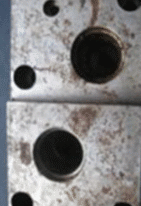Safety and quality notice
Our products: CULLYGRAT®Fe and CULLYGRAT®MS, as well as our company CULLYGRAT®, have absolutely nothing to do with companies that offer "chemical deburring" or that even partially take texts from our descriptions or regulations or are located near us. We guarantee our consistent quality, perfection and the ability to re-form the workpieces processed with CULLYGRAT®.
All Advantages of the CULLYGRAT®
Deburring Process at a Glance
The process is simple and reliable. The quality of the treated parts is improved. A precisely defined, even removal can be reproduced with every further batch.
The processing of standard parts is possible. Easily bendable, filigree workpieces are not exposed to any mechanical loads and can be processed regardless of their structure and size.
Parts with very sensitive surfaces are not damaged. Inside burrs (e.g. angled bores), which cannot be removed at all with conventional techniques or only with great manual effort or by means of explosion deburring on individual parts, are easily deburred with CULLYGRAT® in large numbers and in one pass without deformation.
The surface of the workpieces is metallically pure after treatment. A subsequent galvanic treatment is therefore problem-free. We can even clean rusted parts again - foreign bodies in the workpieces are excluded with CULLYGRAT®. The surface is smoothed down to a residual roughness depth of 0.1 µm.
With CULLYGRAT®, workpieces that are already intended for scrapping can also be reconditioned on a case-by-case basis. There is no hydrogen embrittlement during the treatment - neither with hardened nor unhardened parts. The solution can be kept indefinitely, it only needs to be concentrated.
Due to the simple disposal of the waste water there is no environmental pollution. Approximately 16% are incinerated for disposal. Governments, whose environmental authorities set the strictest requirements for disposal and follow them just as strictly, have gladly given us permission to use CULLYGRAT®.
No skilled workers are required to operate the system. Compared to conventional deburring techniques, personnel and production costs are saved.
The system never has to be shut down.

